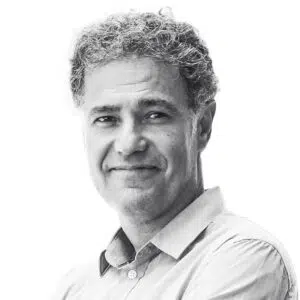- Change Management
- Transformation Sketch
Ride the Waves of Change: Adapting as an Organization-EN

Alfred Maeso Aztarain
Compartir
Now that 2020 is over, without going too far into analyzing it, I think you’ll agree that it has been a year of changes, personally and socially, and of course, organizationally.
In my Change Behavior to Adopt an Agile Culture article, I explained the paradigm shift necessary for organizational change management in order to adapt to this context of accelerated, exponential change.
The Waves of Change
We’ve represented this idea of a paradigm of change in one of our Transformation Sketches. It depicts a person’s perspective shift; at the beginning, they view things in terms of the traditional change curve (we leave stability to tackle a single change, then return to stability) to viewing things in terms of waves of change (continuous, accelerated changes – where the norm is change, not stability).
Ride the Waves
I love using this surfer metaphor to describe the situation of constant change. Change isn’t going away so we need to know how to surf the waves while keeping ourselves afloat and also navigating where we want to go. As the African proverb says, “Smooth seas do not make skillful sailors.”
Each of us has a responsibility to learn how to navigate the roiling sea of change. I’ll say the word “responsibility” again, because I think it is important: the responsibility for adapting to change does not belong to our managers, politicians, or companies, but to each of us as people.
Like an ocean, change isn’t worth fighting against; stability is only an illusion. The most important thing is going to be the attitude with which we face these changes.
Don’t Wipe Out
The paradigm shift in organizational change management begins by putting the focus of change on people. There is no lasting, effective, “good” organizational change without people changing. As Paul Gibbons says in his book “Impact”, “Change is inevitable, whether it represents progress is up to us.”
If you think about it, there is never just a single change. Each person who is going through a change has a different context, different fears, and different ambitions that will make their experience different. Therefore, the effort to adapt will depend on each person. What is easy for some will be very difficult for others. For some, it will be fast; for others, it will take a long time.
This is why traditional organizational change management models based on a framework with initial design and advance planning don’t work.
Specifically, for these three simple reasons:
- Change is constant: adaptation to change cannot be planned as a one-off job, but as a marathon to be developed on an ongoing basis.
- The success of change depends on how each person affected by it adapts to it. The change curve is unique, individual to each person. The focus of organizational change should be on helping people traverse that curve.
- Many of the traditional approaches start from top-down leadership. However, adaptation should occur at all levels and take into account different rhythms and timings.
Learning to Surf the Wave
The organizations must adjust their reality and work continuously, not on a specific change, but on increasing people’s adaptability to change. The definition of “success” for any organizational change, and therefore for change management, will be to leave the organization better prepared for the next change. Developing the capacity to adapt to change is the main objective in a context of constant change.
At the organizational level, we must allow people to develop their capacity individually. This starts by understanding and accepting the premise that change is the true norm, and that stability is the exception. The picture is always moving. We must each learn how to surf the wave and use constant change as a lever continuous learning and growth.
Humanizing Organizational Change
Organizational change will only succeed if people successfully adapt to it.
There are several characteristics that we can work on individually to improve our adaptability. Organizations must work to help their people acquire these characteristics and to create an environment in which people can grow.
The World Economic Forum‘s October 2020 report (“The Future of Jobs”) describes the top 15 skills that will be most sought after and valued by organizations in 2025:
Graphic adaptation by Andy Baraja for “Ride the Waves of Change: Adapting as an Organization”.
Leadership and social influence, critical thinking, active learning, innovation, analytical thinking, and resilience and stress tolerance are just some of the capabilities that each of us can work on to be better prepared for constant change, to surf the waves of change more efficiently. As individuals, identify your gaps and start working on each of them. For companies, create an environment in which people can develop these capabilities.
Gracias,
Alfred

Are you wiping out?
See how our custom change framework can be used to structure and foster change in your organization.
Sobre el autor
